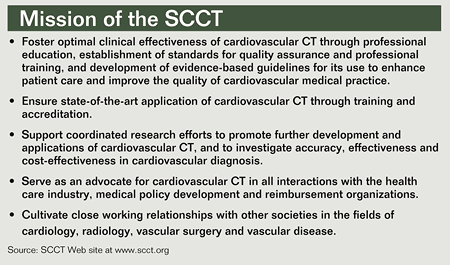New society supports cardiovascular computed tomography
An adequate coding and reimbursement structure for cardiovascular CTA is still needed.
The Society of Cardiovascular Computed Tomography was incorporated in March and membership now exceeds 500, with new applications being received daily.
With interest in the field of computed tomography growing, medical and scientific leaders formed the society to help advance the clinical role of computed tomography in the diagnosis of cardiac and vascular disease.
The society, a professional medical membership organization based in Damascus, Md., acts as an advocate for the cardiologist, supporting research efforts and providing education and training among other efforts.
“Based on clinical evidence, coronary CT is a worthwhile technique that should be widely applied, and it is very important that cardiologists get involved,” said Norbert Wilke, MD, associate professor of radiology, associate professor of medicine and chief of cardiovascular MR and CT at the University of Florida and a board member of the society.
“In the United States, however, there is no reimbursement structure in place to make it a viable diagnostic tool in most practices. One of the major goals of the society is to lobby for adequate coding so that the reimbursement structure is such that these tests can be ordered by cardiologists for the benefit of the patients.”
Growth in CT imaging
Medical use of CT has been growing in general, and many are recognizing its potential in cardiology based on the need for ultra-fine resolution of coronary arteries, said Daniel S. Berman, MD, vice president of the society and director, nuclear cardiology/cardiac imaging at Cedars-Sinai Medical Center.
“CT scanning has had a dramatic change over the last few years, and now manufacturers are offering 64-slice scanners,” said Berman. “For the first time, accurate, noninvasive coronary angiography is available. And the data are coming out — as long as the scanner is 16-slice or better – suggesting that there is about a 95% sensitivity in specificity for CAD.”
Despite medical data supporting CT use, there is still work to be done in establishing codes for billing, education and training, and quality assurance for the clinical use of cardiovascular CT.
 |
SCCT open membership
With an open-door membership policy, cardiologists, radiologists, vascular surgeons, technologists, researchers and anyone interested in the field of cardiovascular CT can join.
“I think there has been a clear statement from the SCCT that the society, while mostly lobbying for cardiologists, would like to work with radiologists in order to make this technology available to our patients,” said Wilke, who is both a cardiologist and a radiologist. “I hope the society can be a bridge between cardiologists and radiologists for the full impact of this technology.”
Wilke hypothesizes that about 80% of cardiology practices would like to start using cardiovascular CT, but a commitment to building the reimbursement structure, education, initial investments and continued quality assurance is needed.
“I think that we are dealing with the most accurate technique for noninvasively assessing the coronary arteries that is currently available. As such, it will become the technique for diagnosing coronary disease in symptomatic patients,” said Berman. “Because of its importance, we need to learn how to use the powerful modality in the best way and learn who really needs it and who doesn’t need it so that it can be used responsibly.” – by Suzanne Bryla
For more information:
- The Society of Cardiovascular Computed Tomography is based at 9929 Main St., Suite C, Damascus, MD 20872; (301) 253-5208; fax: (301) 253-5209; e-mail: info@scct.org; www.scct.org.
